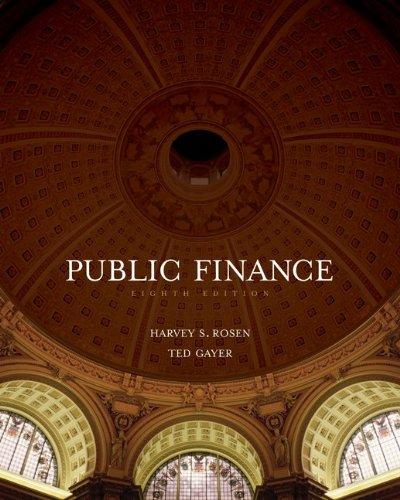Question
Walker, Inc., has no debt outstanding and a total market value of $180,000. Earnings before interest and taxes, EBIT, are projected to be $19,000 if
Walker, Inc., has no debt outstanding and a total market value of $180,000. Earnings before interest and taxes, EBIT, are projected to be $19,000 if economic conditions are normal. If there is an expansion in the economy, then EBIT will be $32,000. If there is a recession, then EBIT will be $15,000. Walker is considering a $66,000 debt issue with a 5% interest rate. The proceeds will be used to repurchase shares of stock (this is known as recapitalization). There are currently 3,000 shares outstanding. Walker has a market-to-book ratio of 1.0.
Topic: Capital Structure and the Effect of Leverage on Earnings
- What is the current price per share for the firms outstanding equity? (Round answer to 2 decimal places)
- Calculate earnings per share (EPS) under normal economic conditions before the firm issues any debt. Assume no taxes. (Round answers to 2 decimal places. Do not round intermediate calculations)
- Calculate earnings per share (EPS) under the economic expansion before the firm issues any debt. Assume no taxes. (Round answers to 2 decimal places. Do not round intermediate calculations)
- Calculate earnings per share (EPS) under the economic recession before the firm issues any debt. Assume no taxes. (Round answers to 2 decimal places. Do not round intermediate calculations)
- Calculate the percentage change in EPS under the economic expansion scenario (relative to a normal economy) before any debt is issued. Assume no taxes. (Answer in percentage terms and round to 2 decimal places. Do not round intermediate calculations.)
- Calculate the percentage change in EPS under the economic recession scenario (relative to a normal economy) before any debt is issued. Assume no taxes. (Answer in percentage terms and round to 2 decimal places. Do not round intermediate calculations.)
- Calculate earnings per share (EPS) under normal economic conditions assuming that the firm goes through with the recapitalization. Assume no taxes. (Round answers to 2 decimal places. Do not round intermediate calculations)
- Calculate earnings per share (EPS) under the economic expansion assuming that the firm goes through with the recapitalization. Assume no taxes. (Round answers to 2 decimal places. Do not round intermediate calculations)
- Calculate earnings per share (EPS) under the economic recession assuming that the firm goes through with the recapitalization. Assume no taxes. (Round answers to 2 decimal places. Do not round intermediate calculations)
- Repeat part (g) assuming a corporate tax rate of 35%. (Round answers to 2 decimal places. Do not round intermediate calculations)
- Repeat part (h) assuming a corporate tax rate of 35%. (Round answers to 2 decimal places. Do not round intermediate calculations)
- Repeat part (i) assuming a corporate tax rate of 35%. (Round answers to 2 decimal places. Do not round intermediate calculations)
- Calculate return on equity (ROE) under normal economic conditions before the firm issues any debt. Assume no taxes. (Answer in percentage terms and round to 2 decimal places. Do not round intermediate calculations.)
- Calculate return on equity (ROE) under the economic expansion before the firm issues any debt. Assume no taxes. (Answer in percentage terms and round to 2 decimal places. Do not round intermediate calculations.)
- Calculate return on equity (ROE) under the economic recession before the firm issues any debt. Assume no taxes. (Answer in percentage terms and round to 2 decimal places. Do not round intermediate calculations.)
- Calculate return on equity (ROE) under normal economic conditions assuming that the firm goes through with the recapitalization. Assume no taxes. (Answer in percentage terms and round to 2 decimal places. Do not round intermediate calculations.)
- Calculate return on equity (ROE) under the economic expansion assuming that the firm goes through with the recapitalization. Assume no taxes. (Answer in percentage terms and round to 2 decimal places. Do not round intermediate calculations.)
- Calculate return on equity (ROE) under the economic recession assuming that the firm goes through with the recapitalization. Assume no taxes. (Answer in percentage terms and round to 2 decimal places. Do not round intermediate calculations.)
- Repeat part (p) assuming a corporate tax rate of 35%. (Answer in percentage terms and round to 2 decimal places. Do not round intermediate calculations.)
- Repeat part (q) assuming a corporate tax rate of 35%. (Answer in percentage terms and round to 2 decimal places. Do not round intermediate calculations.)
- Repeat part (r) assuming a corporate tax rate of 35%. (Answer in percentage terms and round to 2 decimal places. Do not round intermediate calculations.)
- What is the break-even EBIT under normal economic conditions between the levered and unlevered capital structures? (Round answer to 0 decimal places)
Step by Step Solution
There are 3 Steps involved in it
Step: 1

Get Instant Access to Expert-Tailored Solutions
See step-by-step solutions with expert insights and AI powered tools for academic success
Step: 2

Step: 3

Ace Your Homework with AI
Get the answers you need in no time with our AI-driven, step-by-step assistance
Get Started


